Ancient Egyptian religion had no official book equivalent to the Bible or the Quran.
The relationship between the deities did not become fixed at one moment in time but went on changing and developing for thousands of years.
Egyptian mythology was never condensed into one authorized form and had to be glued together from a variety of written and visual sources here and there.
The remainder of this article will give a historical overview of the most worshipped Ancient Egyptian Gods:
10. Geb
Content
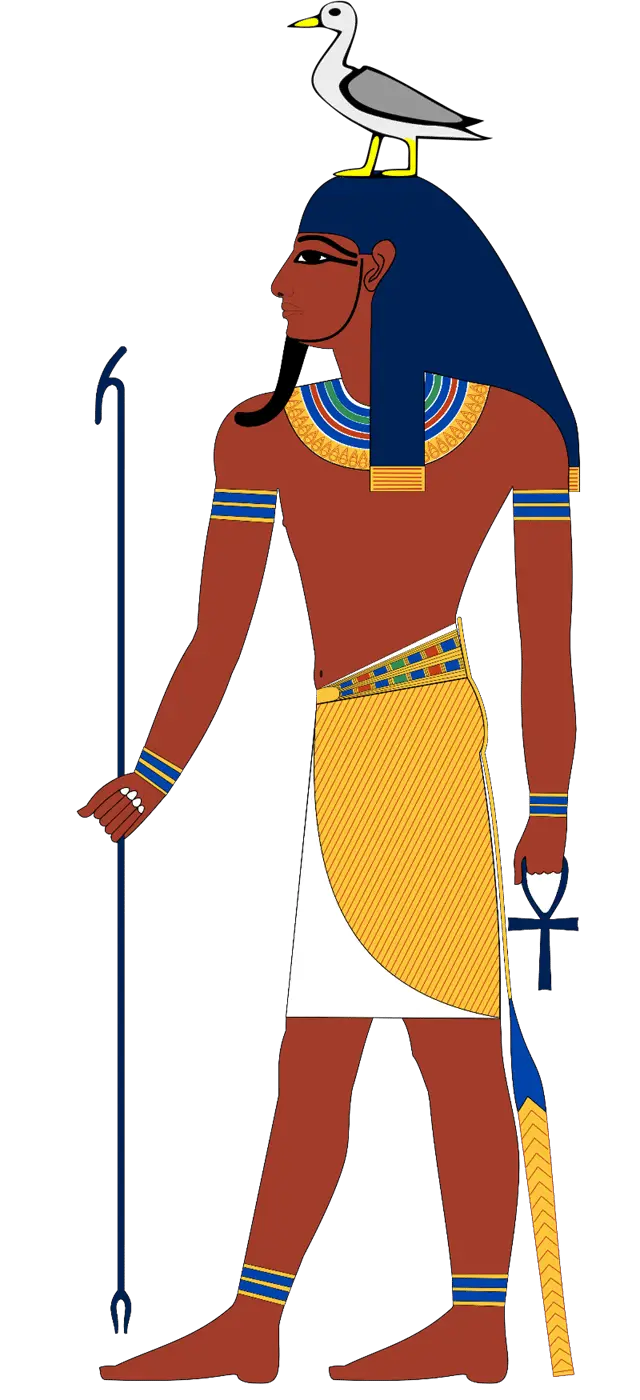
Source: Wikimedia Common
The God of Earth, Geb, is adorned with many titles such as Chief of Gods, The Great Cackler or the Father of the Gods.
He was one of the Ennead of Heliopolis, the nine beings who descended to Earth from the Sirius star system.
Geb, the offspring of Su and Tefnut, is a third-generation deity and as the brother of the consort of Nut, becomes the father of Isis and Osiris.
He appears on papyri from the New Kingdom typically wearing the crown of Lower Egypt, lying on the ground with his arms stretched in the opposite directions: one to the sky, one to the Earth.
He is conspicuously seen coloured green with greenery growing from him. He has healing powers, particularly protecting against Scorpion stings.
As a god concerned with the dispute between Horus and Seth, he is also an arbitrator between good and evil.
9. Sekhmet
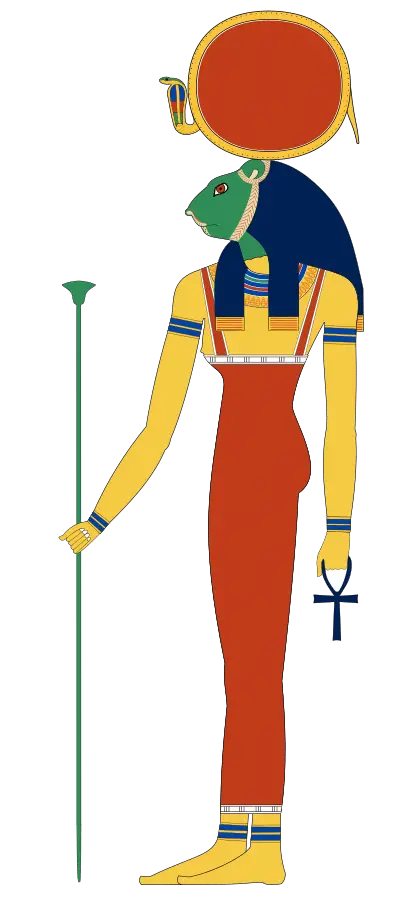
Source: Wikimedia Common
The ultimate embodiment of female power, Sekhmet was adorned by many titles and known by a characteristic of donning a red dress. Her name implies ‘she who is powerful’. She was the Goddess of Sun, Chaos, War, and Healing.
Legend has it that Ra looked upon the Earth and kindled a fire from his eyes. The spark that jolted out birthed Sekhmet.
Ra created her to kill any earthling who disobeyed him and trespassed the principles of Ma’at. She is often depicted in human form as a woman with the head of a lion with a sun disk.
Sekhmet is also seen both as a healer and a terrifying goddess. She could protect people from all kinds of plagues and heal them or even avert them. She was the tool of Ra to avenge people.
Hence, she could bring forth plagues too. For the same reason, she was called The Lady of Pestilence. To be on her side, Egyptians (including pharaohs) prayed to her and bestowed offerings.
Her epithet reads ‘The One Before Whom Evil Trembles’, which reflects her ferocity. As a warrior goddess, she had a lust for bloodshed. It is said that she once almost wiped out the entire population of Egypt, leaving it a big pool of blood.
She is symbolized as a woman with the head of a lioness. Her head boasted a sun disk and the uraeus serpent, representing immortality.
Often she was seen with little or no clothing, which was unusual for Egyptian gods. One of her hands possesses the ankh and the other a sceptre.
8. Hathor

Source: Wikimedia Common
Hathor is the Egyptian Mother Goddess or Goddess of Love. She was worshipped from the Old Kingdom (circa 2700 BC), or earlier, until the end of Egyptian history (circa AD 400).
Hathor is ascribed with a gentle nature and charged with creative forces. Itis said that she restored what Sekhmet destroyed.
Thus, she was depicted invariably like a cow goddess in one or many forms. For her powers of the sky, she was known as ‘Lady of the Stars’.
Her father is the sun god Ra and she is often described as the mother of all Egyptian pharaohs.
In art, she may be depicted as a cow, as in the sculpture of her browsing among papyrus plants and suckling the pharaoh Amenhotep II from the Hathor sanctuary of Tuthmosis III, or in human form wearing a hairstyle which mimics the Mesopotamian omega symbol.
She is also represented in the capitals of architectural columns and sometimes associated with lions. Other symbols include the papyrus reed and the snake.
She was very popular in the Greco-Roman culture and many elements in the making of Aphrodite were borrowed from her model.
7. Thoth
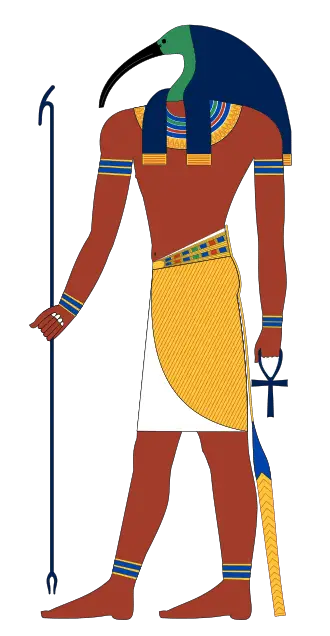
Source: Wikimedia Common
The God of Knowledge and Wisdom, Thoth, is the first to conjure up the first words and the whole idea of writing.
Not only that, he has devised multiple branches of knowledge. He emerged from the lips of Ra is one of the mythological folklores, while others claim that he was self-created.
He is embodied in the human form having the head of Ibis, the holy bird of wisdom. Thoth is also a Greek translation of the original Egyptian name Djehuti, which means ‘He Who Is Like The Ibis’.
He is often pictured holding an ankh and a sceptre, while other times he is seen holding a palette and a stylus.
Thoth is the writer of the book, ‘Book of the Dead’. He was also the scribe of the underworld. He stayed up weighing the hearts of the dead and sent those lighter hearts up into the heavenly sphere.
He kept time accurately and measured it well and appropriately got the epithet ‘The Reckoner of Time and Seasons.’
The waxing and waning of the moon played a chief role for the Egyptians, where he was initially regarded as the Moon God as the crescent moon symbolizes Ibis, the bird affiliated to Thoth.
An interesting fact is that Thoth penned about 42 books in his lifetime. Thus, he was titled as ‘Author of Every Book on Every Branch of Knowledge, Both Human and Divine’.
He condensed all universal knowledge that sufficed all beings-mortal and immortal in his books. Some of them were so powerful that it couldn’t be revealed to anyone.
6. Horus
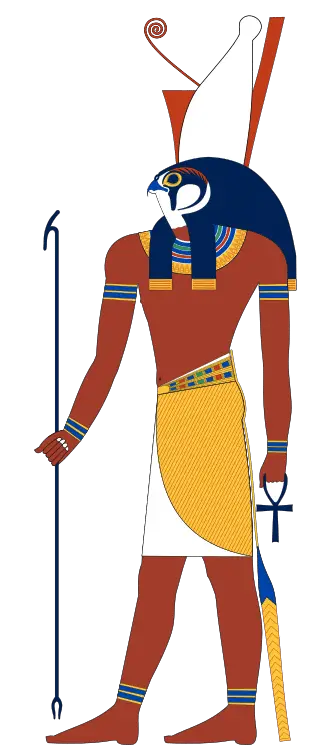
Source: Wikimedia Common
Horus or the high one is the Egyptian God of Sky. He was worshipped from circa 3000 BC until the end of Egyptian history.
He is one of the most universally important gods in the Egyptian pantheon attested from the earliest recorded period. By tradition born at Khemmis, in the Nile delta region, Horus’s father was the dead Osiris, his mother was Isis, but a complex genealogy identified him distinctly as Horus, Horus the child (Harpokrates) and Horus the Elder.
Legend follows that he was the first ruler of all Egypt, after an eighty-year struggle for supremacy with his brother and rival, Seth.
Horus’s symbol is the falcon and he is generally depicted either wholly as a hawk or in human form with a falcon’s head.
He is also recognized as the ‘Eye of Horus’- a human eye adorned with the Egyptian extension and demarcated by the markings representing the cheeks of a falcon. Similarly, he has various other symbols as Harpokrates and Horus, the Elder.
The Eye of the Horus arises from the legend that his rival, Seth, had yanked out Horus’s eye. Although the eye was reinstalled by his mother, the incident consolidated into a legendary myth. The symbol can represent the security of kingship, perfection and protection against the evil influence of Seth.
5. Ra
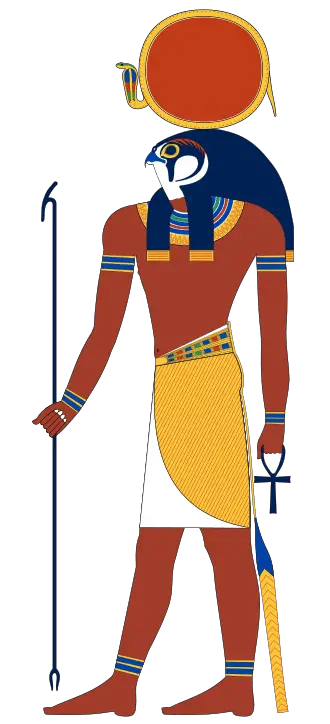
Source: Wikimedia Common
God of the Sun, the King of Gods, and Mortals are some of the most common titles of Ra. He is also recognized with other names such as Re, Amun-Re, Khepri, etc. depending on his forms of being. Often, he incorporated other Egyptian deities. The story of his origin is debatable as some say he was self-created while others state the byproduct of the coming together of two other gods.
Collectively with Ra at the helm as the principal deity known as Ra-Horakte, they are known as the Ennead of Heliopolis. However, Ra was the supreme power in the universe and the godhead in the Egyptian pantheon. All the other gods were merely the aspects of Ra. Precisely, other gods were his descendants.
As the God of Sun, he rode on a golden chariot, spreading warmth and light to the earthlings. Even when the sun went down, he brought freshness into the underworld dwellers. He is often associated with Phoenix for his ability to rise each morning, albeit setting down at night, every day.
In ancient art, he is represented with a falcon head and a solar disk on his head. The chief centre of Ra’s cult was Heliopolis (city of the sun). He ascended the throne of divinity from the eighth dynasty (circa 2400 BC) and later amalgamated with the Theban god, Amun.
4. Anubis
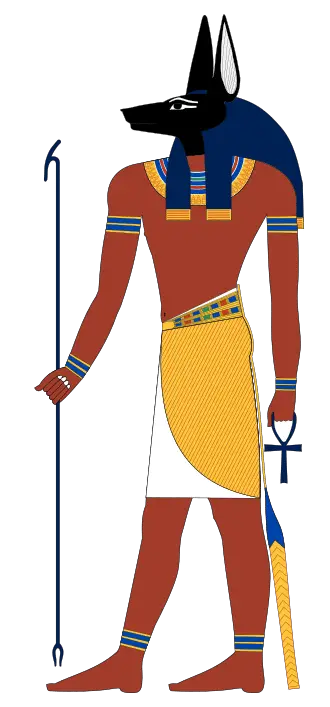
Source: Wikimedia Common
He was the Egyptian mortuary God or the God of Death, worshipped during circa 2700 BC until the end of Egyptian history circa AD 400. The centre of his cult lied in the necropolis at Memphis and elsewhere.
The parentage of Anubis is confused but the most popular notion seems to place him as a son of Re and Nephthys or Isis. He is generally seen as a black dog or a jackal with tall ears and crouching with his tail hanging behind. Clad in a collar with magical connotations, he is depicted as a human having a dog-head.
Perhaps, the concept of a dog emerged by observing the carcass being scavenged and a determination to protect the corpses by Anubis manifesting into a dog.
Anubis used to supervise the after death deeds like embalming and linen bandaging of the elites like the kings and his courtiers. His coat had blackened over time by the use of black tar to seal the body with linen bindings.
His symbol is headless, whose blood is dripping down and wearing an animal hide. His main cemeteries were situated on the banks of Nile, where an epithet reads He Who is Upon the Mountain. It implies the presence of Anubis above the mountains where he resides with his watchful eyes.
3. Osiris
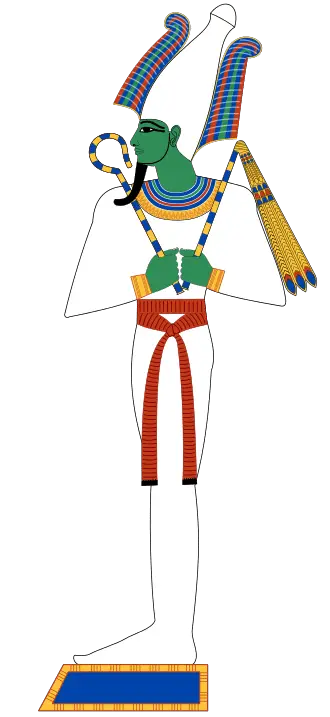
Source: Wikimedia Common
Osiris is the Egyptian Goddess of Underworld and also the God of Vegetation and Corn. His period of worship was from circa 3000 BC until the end of Egyptian history circa AD 400.
Osiris is among the most worshipped and revered deities in the Egyptian pantheon. According to the genealogy at Heliopolis, he was born at Rosetau in the necropolis (gate to the underworld) of Memphis. His parents were Geb and Nut and he was the eldest of four siblings.
Osiris is depicted in human form as a body covered in linen. He is a mummy with free arms, holding a crook and flail on each hand. His crown possesses the peculiar white-coloured conical crown of Lower Egypt. Green is his skin colour and is seen as the counterpart in death of the sun god Ra.
As the grain god, Osiris was worshipped in the form of a sack filled with seed, which sprouted green. He is also depicted by models with articulated members which women paraded through the streets at festivals and manipulated to demonstrate the god’s virility. His relationship with the Egyptian kingship was crucial. Each king was the divine embodiment of Horus in life but became Osiris in death.
2. Mut

Source: Wikimedia Common
Mut is the Egyptian mother goddess of both worlds: Upper Egypt and Lower Egypt.
She replaced the goddess Amaunet and became the other half of the sun god Amun and the mother of Khonsu, the moon god. The Theban kings regarded her as the cosmic mother. After Amun became Amun-Ra, she amalgamated with the mother of Horus, Hathor (wife of Ra). Consequently, she earned the title of The Eye of Ra, protecting the god throughout his journey in the sky. Eventually, she was a member of Ennead.
Mut was depicted in human form as a woman crowned with a vulture headdress, the top of which adorned by both the crowns of Upper and Lower Egypt. Her image dons a red or a blue dress. She was occasionally seen with the head of a lioness or even a cobra.
Iseru, her sanctuary at Thebes, was the religious precinct for more than 2000 years. Together with Amun and their child, Khonsu, she completed the Triad of Waset.
Originating from the delta of the Nile, she was heralded as the mother of the cosmos. Widely recognized as the goddess of creation, she was associated with many gods and goddesses. Hence, portrayed as a composite god. Thus, she is also known as the Lady of Heaven and World-Mother. The word Mut itself implies mother.
1. Amun-Ra
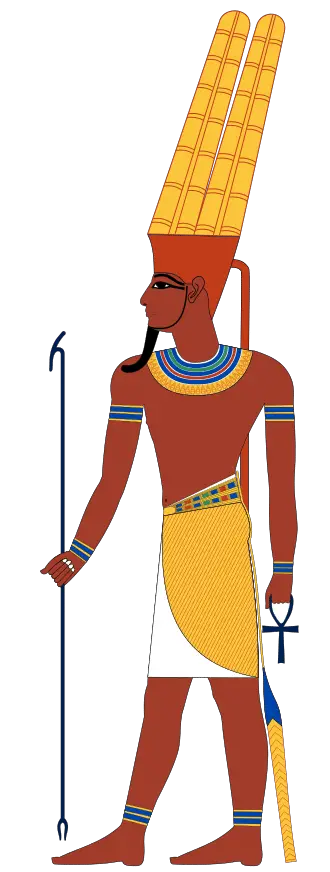
Source: Wikimedia Common
The Supreme Creator God, Amun-Ra or Amon was worshipped probably from preDynastic to the end of the Egyptian period, circa AD 400. The centres of his cult were widespread in Karnak and even beyond Egyptian borders. He merged with the sun god Ra and became Amun-Ra.
Amun is a sun god, lord of the sky and the king of the Egyptian world. He is perceived as a primaeval deity present in chaos at the creation of the cosmos and was, therefore, also one of the eight gods of the Ogdoad coupled with the goddess, Amunet and representing hidden power.
He is portrayed as a pharaoh, with blue skin and wearing a modius (turban) surmounted by two tall plumes of feathers symbolic of dominance over both Upper and Lower Egypt.
He is symbolized by a ram with curved horns for whom the Nile goose is sacred. He is a god regarded as hidden but spreading throughout the cosmos, unseen but omnipresent. Best described in hymns anthropomorphically as ‘hidden of aspect, mysterious of form.” (Amun-hidden; Ra-Light)
In the New Kingdom, he was ascribed as the ancient sun god of Heliopolis, which effectively raised his prestige and earned him the title of ‘King of the Gods.’ At Thebes, he was revered as a snake god with attendant connotations of immortality and endless renewal. During the early Greek civilizations, he was synonymous to Zeus.
Conclusion
There are only a few places on Earth that are the cavern of mystery. One of them is Egypt. Centuries have gone by yet the walls adorned by the portraits, figurines, statuettes and engravings of these highly revered Egyptian gods still resonate with those who find meaning in them.
These deities were not only dominant during the Egyptian reign but subsequently influenced the Roman invaded Egypt. Most Greco-Roman figures restored their precincts and worship areas, further fortifying their power and glory. Thus, they survived for over three millennia and made way into our article today.
